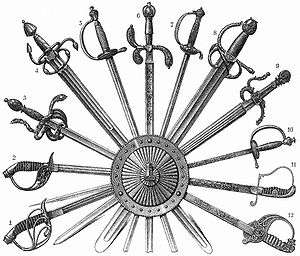Urumi
| Urumi | |
|---|---|
 A pair of multi-bladed urumi | |
| Type | Sword |
| Place of origin | South Asia |
| Specifications | |
| Length | approx. 122–168 cm (48–66 in) |
| Part of a series on |
| Indian martial arts |
|---|
 |
| Styles |
|
| Legendary Figures |
| Notable Practitioners |
| Related terms |
The urumi (Malayalam: ഉറുമി, urumi; Tamil: உறுமி, urumi, Sinhalese: එතුණු කඩුව ethunu kaduwa; Hindi: āra) is a sword with a flexible whip-like blade from South Asia. Originating in what are now southern India and Sri Lanka, it is thought to have existed from as early as the Sangam period.
The urumi is considered one of the most difficult weapons to master due to the risk of injuring oneself. It is treated as a steel whip[1] and therefore requires prior knowledge of that weapon as well as the sword. For this reason, the urumi is always taught last in Indian martial arts.
The word urumi is of north Keralan origin. In the state's southern region, it is more commonly called a chuttuval, from the words for coiling or spinning (chuttu) and sword (val).[1] Alternative Tamil names for the weapon are surul katti (curling sword) surul val (curling blade) and surul pattakatti (சுருள் பட்டாக்கத்தி).
Anatomy
The urumi hilt is constructed from iron or brass and is identical to that of the talwar, complete with a crossguard and frequently a slender knucklebow. The typical handle is termed a "disc hilt" from the prominent disc-shaped flange surrounding the pommel. The pommel often has a short decorative spike-like protrusion projecting from its centre. The blade is fashioned from flexible edged steel measuring three-quarters to one inch in width. Ideally the length of the blade should be the same as the wielder's armspan, usually between 4 feet to 5.5 feet. Multiple blades are often attached to a single handle. The Sri Lankan variation can have up to 32 blades and is typically dual-wielded, with one in each hand.[2]
Use

The urumi is handled like a flail arm but requires less strength since the blade combined with centrifugal force is sufficient to inflict injury. As with other "soft" weapons, urumi-wielders learn to follow and control the momentum of the blade with each swing, thus techniques include spins and agile maneuvres.[1] These long-reaching spins make the weapon particularly well-suited to fighting against multiple opponents. When not in use, the urumi is worn coiled around the waist like a belt, with the handle at the wearer's side like a conventional sword.[1]
In popular culture
A peptide found in the mucus of a South Indian frog is termed as urumin. This name is inspired from the urumi, since urumin kills the H1-N1 flu virus effectively.[3][4]
See also
References
- 1 2 3 4 Saravanan, T. (2005). "Valorous Sports Metro Plus Madurai". The Hindu.
- ↑ Helaye Satan Rahasa Angam, Lankadeepa Article.
- ↑ South Indian Frog Oozes Molecule That Inexplicably Decimates Flu Viruses
- ↑ Holthausen David J., Hee Lee Song, Kumar Vineeth TV, Bouvier Nicole M., Krammer Florian, Ellebedy Ali H., Wrammert Jens, Lowen Anice C., George Sanil, Radhakrishna Pillai Madhavan, Jacob Joshy (2017). "An Amphibian Host Defense Peptide Is Virucidal for Human H1 Hemagglutinin-Bearing Influenza Viruses". Immunity. 46: 587–595. doi:10.1016/j.immuni.2017.03.018.
